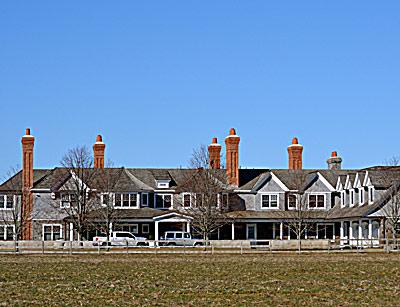Much Ado About Camp Farrell

A three-floor, 31,000-square-foot compound on Halsey Lane in Bridgehampton, which is listed for sale for $49.5 million, raised the hackles of neighbors last month when its owner, Joe Farrell, a prominent builder of luxury houses on the South Fork, applied for permission to build an equestrian barn on his property.
The spread, called Camp Farrell, includes a 12-bedroom house on a 3-acre parcel where Mr. Farrell and his wife and three children now live, and an adjacent 8.6-acre reserve, where a 4,410-square-foot barn is proposed that would house seven horses. It would add to the outdoor features of the compound, which already include a sunken tennis court, 60-foot swimming pool, and a baseball field.
The house, which is named “Sandcastle,” is designed around a recreational pavilion, which has a 10-seat interactive theater, a D.J. booth, a spa and gym, basketball and squash courts, a two-lane bowling alley, rock wall, and a half-pipe skateboard ramp. According to the Web site Curbed Hamptons, it can be rented for two weeks in August for $550,000.
The application now before the Southampton Town Planning Board is for a special exception permit for the barn and permission to relocate a deeded 20-foot-wide right of way onto the agricultural reserve, which had been set aside by the former owner of the property, Ahmet Ertegun, in 1999.
At a well-attended public hearing of the planning board on Feb. 9, several neighbors spoke in opposition to the barn and took issue with the relocation of a gravel driveway.
In an interview on Tuesday, Kristen Farrell called the house the “most detailed home yet.” Although it is listed for sale, she said “it was not our intention to sell it.” She explained that having the house on the market made it possible for prospective customers to see what the Farrell construction company was capable of. However, she added that they would sell it if the right offer were made.
Debra Srb, a neighbor since 1994, objected to moving the access, fearing it would decrease the value of her property. She also complained about glaring spotlights, A.T.V.s, and the use of sprinklers and removal of sod on the reserve. Another neighbor, Daniel Rosen, called the proposal an inappropriate use of an agricultural reserve. He said that the deeded easement called for “no streets [or] roadways for non-farming use.” He also said the reserve was smaller than the 10 acres required as a minimum for equestrian barns in the town’s zoning code.
Ms. Farrell disagreed. She said the code allowed the planning board to approve barns on smaller parcels provided they were for fewer than 10 horses and for private use. The relocation of the driveway had been a planning board recommendation, Ms. Farrell added. The driveway had been a planning board recommendation, Ms. Farrell added. The original access would have gone through neighbors’ yards and right beside a swimming pool, she said.
Ms. Farrell said she was not prepared for the neighbors’ comments at the hearing, neighbors whose grandchildren, she said, have played baseball on their property. She alleged that other neighbors knew about the plans when purchasing their house. And, she added, those who complained at the hearing about parties on the property had not noted that they were benefits, for hospitals and other local causes.
Mr. Farrell’s attorney, John Bennett, said on Tuesday that the proposed equestrian use was traditional and neither invasive nor dangerous, as another agricultural use, such as crop farming with pesticides, fertilizers, and fungicides, might be. He clarified a misconception that the barn required a variance, saying it was instead “a use permitted upon special exception, appropriate to the area.”
“I guess the neighbors have no sense of mom and apple pie,” Mr. Bennett said, “They are against horses and baseball?”
The only variance involved, Ms. Farrell said, is a matter of 10 feet. “The horse farm makes sense. It’s an equestrian community.” She said the couple were in no rush to complete the project, but believe they should have permission in place.
According to documents on file, Bruce Anderson of Suffolk Environmental Consulting, a private firm, agreed “the use is consistent with the agricultural easement.” He confirmed, after questioning at the hearing, that the horses would be for private use, not for boarding, equestrian events, or commercial enterprise.
The planning board had sent letters asking for recommendations to the Bridgehampton advisory council, the Southampton Fire Department and fire marshal, and the town agricultural advisory committee, engineer, and conservation board, and the county planner and Department of Health. It had left the hearing open for comments for 30 days, so a decision may be imminent.
